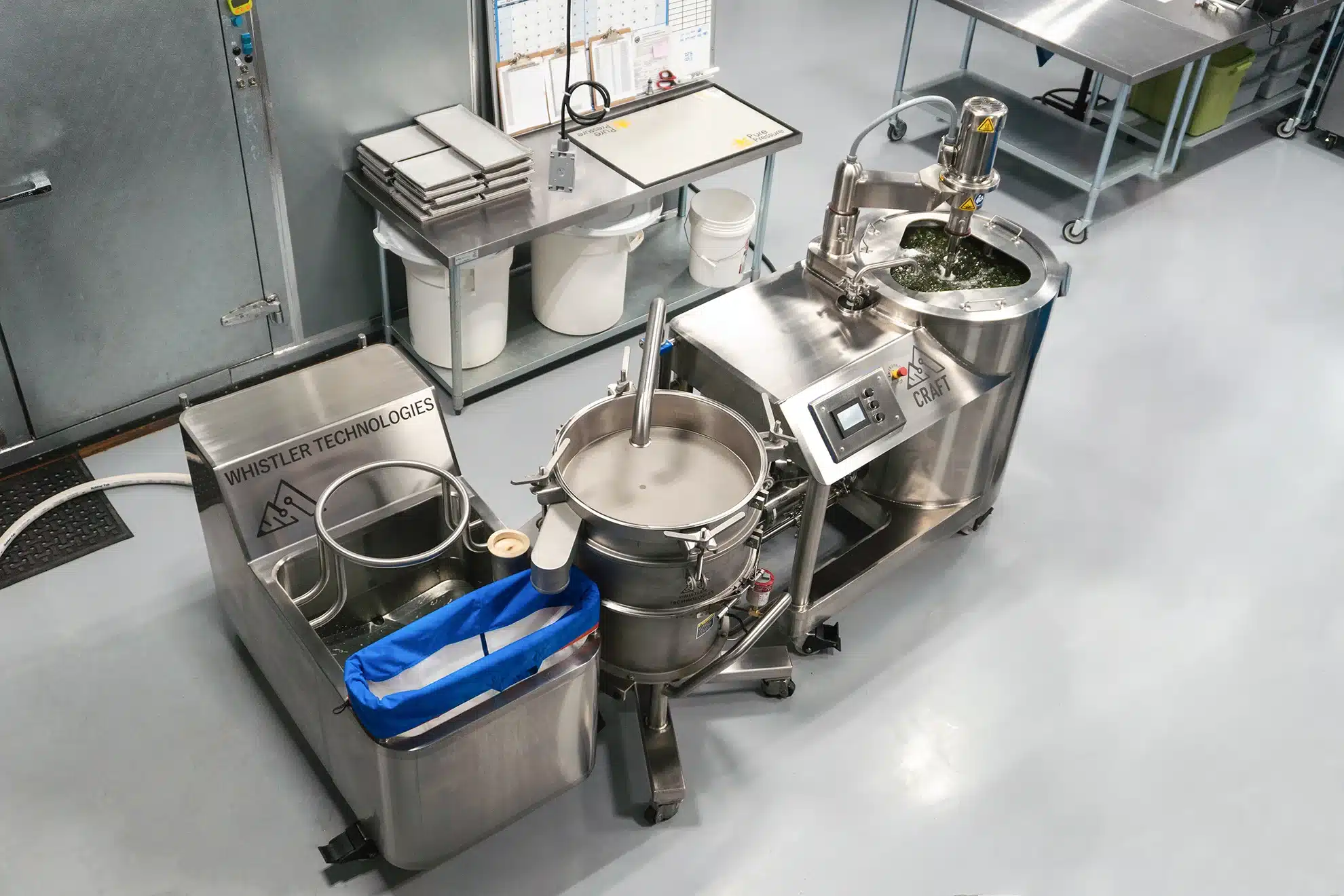With the evolution of the cannabis industry, specialized equipment for cannabis extraction has become a critical component of product development. If you are planning to foray into cannabis processing or product development, understanding the cannabis extraction equipment cost is essential.
This guide explores different extraction technologies, their associated costs, and the key considerations that influence the overall setup cost.
Sections
ToggleKey Factors Influencing Cannabis Extraction Equipment Cost
Several factors come into play, influencing the final cannabis extraction equipment cost.
1. Extraction Method (CO2, Hydrocarbon, Ethanol, Solventless, etc.)
The extraction method a facility will utilize decides the type of equipment required. From conventional rosin presses to specialized CO2 extraction equipment, there is a significant difference in initial investment and operational costs.
2. Processing Volume / Throughput
Equipment designed for commercial-scale production has higher prices. Smaller systems come with a lower cost but have limited capacity.
3. Automation and Engineering Design
Manual systems like presses are cheaper but require more staff for operations. Comparatively, automated systems reduce labor costs and increase product consistency. However, automated cannabis extraction equipment comes with higher upfront costs.
4. Quality of Materials and Build
Depending on build quality, the prices can vary. For instance, the CBD extraction machine cost for medical-grade operations with precision engineering will be priced much higher than a machine designed for conventional product processing.
5. Compliance (C1D1/C1D2 certifications)
Cannabis extraction equipment that meets industry safety standards and regulatory requirements will cost more. There are additional engineering considerations involved in manufacturing compliant machines, so the manufacturing cost is higher.
6. After-sales Support and Warranty
Service charges and extended warranties add to initial costs. However, after-sales support is crucial for long-term protection, and technical support is essential for operational continuity.
Cannabis Extraction Equipment Cost Comparison
Extraction Equipment | Cost Range | Pros | Ideal Use Case | Key Considerations |
Hydrocarbon Extraction | $30,000 – $250,000 | High throughput, preserves terpene, versatile | For full-spectrum cannabis extracts | Strict safety regulations requirements, handling of volatile solvents |
Ethanol Extraction | $20,000 – $500,000+ | Established process (widely used in food processing), scalable, efficient for high-volume processing | Large-scale CBD isolation, distillate production | Solvent recovery costs, lower terpene preservation |
CO2 Extraction | $100,000 – $800,000+ | CO2 is inert classified as solventless process, clean extracts, precise parameter control | Highly recommended for pharmaceutical-grade production, offers highly precise terpene isolation | High initial investment, training for operators to operate specialized equipment |
Solventless (Rosin Press) | $3,000 – $60,000 | Low startup cost, minimal regulatory hurdles, “solvent-free, clean” market appeal | Experimental producers, natural premium concentrates | Labor-intensive process, lower throughput, limited scalability |
Rotary Evaporators (Rotovaps) | $5,000 – $40,000 | Distillate production, excellent solvent recovery, adaptable to multiple processes | Post-processing for multiple extraction methods for purer extracts | Not standalone solution, additional equipment required |
Short Path Distillation | $10,000 – $100,000+ | Produces high-purity isolates, crucial for vape products | Targeting specific cannabinoid profiles in extracts | Requires technical expertise, additional post-processing step involved |
Hemp Oil Extraction | $15,000 – $450,000 | Optimized for hemp processing, high throughput | CBD product manufacturing | Biomass quality considerations, regulatory differences |
Total Cost of Ownership (Beyond Equipment Price)
Cost Factors | Description |
Installation & Setup | Professional installation services including facility modifications and utility installation can cost around $5,000-$30,000 |
Training | Creating and implementing training programs including ongoing education and consulting services can cost $2,000-$10,000 |
Maintenance & Repairs | A typical cannabis extraction facility spends around $5,000-$20,000 annually on regular maintenance schedules, parts replacement, andin downtime costs |
Regulatory Compliance | Inspections, certifications, documentation, and safety protocols compliance may add another $10,000-$50,000 annually |
Post-Extraction Processing | Additional equipment for winterization, filtration, or decarboxylation can cost $20,000-$150,000 |
Compliance and Safety: The Hidden Cost Factor
The cannabis extraction industry is subject to several compliance and safety regulations, including:
C1D1/C1D2 ratings
For compliant cannabis extraction operations, it’s essential to understand specialized facilities requirements classified as Class 1 Division 1 (C1D1) or Class 1 Division 2 (C1D2) rooms. This adds to the cannabis extraction equipment cost, adding $50,000-$150,000 to the total investment for creating environments to contain potentially explosive atmospheres created during solvent-based extraction processes safely.
Safety Upgrades and Certifications Required
Most jurisdictions require cannabis processing facilities to use third-party certified equipment, emergency protocols, ventilation systems, and electrical installations. These certifications ensure operator safety and add significant costs, usually 15-30% to your total investment.
Engineering and Automation: Are You Paying for Efficiency?
Cannabis processing has significantly evolved, with engineering and automation playing a pivotal role. The sophistication of engineering design directly impacts both equipment cost and operational efficiency. Fully automated systems with precision controls, data logging, and remote monitoring capabilities will cost much more, but reduce labor costs by 40-60%. Consider if the higher upfront CBD extraction machine cost translates to lower operating costs in the long run.
Quality of Materials and Manufacturing Standards
The quality of manufacturing of equipment also impacts cannabis extraction equipment cost. Laboratory-grade stainless steel, pharmaceutical-grade gaskets and seals, and precision-machined components ensure high purity of the extracts. Lower-quality equipment may reduce initial costs but lead to contamination risks, frequent replacements, and product quality issues. There can be a 25-40% price difference between industrial-grade and pharmaceutical-grade extraction systems.
Why Choose Root Sciences?
Root Sciences offers turnkey solutions that streamline the extraction process and ensure that your equipment is compliant, high-performing, and easy to maintain. Our systems have earned the trust of 400 processors worldwide for nearly a decade. Every Root Sciences cannabis extraction equipment is designed to integrate seamlessly with distillation and post-processing setups, ensuring a comprehensive cannabis production solution.
Partnering with Root Sciences offers several key advantages:
- Comprehensive catalogue of processing equipment for the cannabis industry
- Equipment validated for commercial cannabis applications
- Complete facility/lab design solutions
- Consulting services from industry experts with practical extraction experience
Conclusion
Setting up a cannabis extraction facility involves several costs, the most significant of which is the cost of cannabis extraction equipment. When evaluating equipment cost, it’s essential to consider more than the upfront cost. Many factors influence the cost, from facility requirements and regulatory compliance to operational expenses and long-term maintenance. An entry-level CBD extraction machine cost can be as low as $10,000 for basic solventless equipment. In contrast, commercial setups with supercritical CO2 extraction equipment can exceed $1 million for fully automated, pharmaceutical-grade installations. The choice of the right extraction technology and underlying cost depends on your facility design, target products, and scale of operation.




